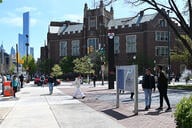You have /5 articles left.
Sign up for a free account or log in.

iStock.com/sshepard
In surveys, polling data and lawsuits, the message from students is clear: we expect to pay less for online instruction.
Though many colleges and universities have not bowed to that pressure, some are now offering substantial tuition discounts.
The list is a diverse mix of more than a dozen institutions, including Princeton University, Southern New Hampshire University, Paul Quinn College, Spelman College, Rowan University and Lafayette College.
Since Inside Higher Ed last wrote about this trend in late July, the list has grown with the additions of Johns Hopkins University and National University.
Many universities are choosing to cut by 10 percent, including Johns Hopkins, Georgetown University and Lafayette College.
Others will be cut even deeper. Thomas University will slash its tuition rates by roughly 30 percent and Paul Quin by about 28 percent.
Some colleges are instead choosing to freeze tuition, defer payments or slash student activity fees (since student activities will be limited at best this fall at many institutions).
In the case of National University, the tuition cut will not be an across-the-board discount on the sticker price of attendance. Instead, the university is doubling awards for existing scholarships and giving students a free fourth course after they sign up for three, to incentivize completion. National is placing another $30 million into scholarships for disrupted workers. Overall the discounts will work out to about 25 percent, officials at National said.
The approach is somewhat similar to that of Southern New Hampshire University, which is providing a free year for first-year students and discounting tuition by 61 percent overall by 2021, though those discounts apply to only to students enrolled in campus-based programs.
Both institutions are large nonprofits and mostly serve students online.
Some other universities, such as Pacific Lutheran University, instead will give students a free fifth year after they complete their degrees.
Robert Massa, vice president emeritus of enrollment at Dickinson College, said the universities offering tuition discounts roughly fall into two categories. There are the well-endowed, selective ones, such as Princeton, Williams, Georgetown and Johns Hopkins, many of which have coalesced around 10 percent as a discount. Those colleges can afford to discount easily, unlike their peers that are somewhat selective, but not as well-endowed. And then there are non-selective institutions in a lower market position, which need to cut tuition to stay competitive and attract students.
David Andrews, National's president, said the university was charged by its board to find ways to lower prices before the pandemic hit the United States, and that the pandemic and its attendant economic downturn have not negatively impacted National's enrollment.
"It's an institutional commitment in terms of access and equity to cut the price to make tuition more affordable and access in general more acceptable to underserved populations," he said. "We were 80 percent online anyway so we weren't really trying to offset our students' perception that online was somehow less valuable than face-to-face. We're not faced with trying to recover losses on residence halls because we don't have any."
With the targeted approach at National, it is possible that some students may see a large discount, while others see none. For example, many nursing students, who are expensive for a university to educate and are often on their way to well-paying jobs, Andrews said, will not be seeing a discount and will only have the cost reduced if they qualify for scholarships.
Some enrollment experts, including Massa, have advocated for a targeted approach, such as increasing aid to individual students who have a decreased ability to pay, rather than cutting sticker price. An overall price cut for everyone in some cases most benefits wealthier students and families.
Carol Stack, a principal at higher education consultancy EAB, said another tactic colleges should consider is a "COVID grant," a line item, fixed price discount for every student tied to the pandemic.
"It very clearly says to students and to families, 'this reduction in price is tied to the pandemic and tied to what we're unable to do because of that,'" she said. "It's really easy with a grant to be nimble and make alterations into the future. But once you've actually reduced your tuition it can be hard to have the conversation to increase that back up to the prior level."
Downward pressure on tuition was apparent before the pandemic, as net tuition revenue, the amount colleges take in after discounting, has remained flat during recent years. The pandemic has tightened a squeeze on pricing that originally was borne from demographic and economic changes in the United States, as well as negative public commentary on the value of a college degree.
While some have imagined running online classes will be cheaper for colleges than operating in-person classes (and thus argued for discounted tuition), Stack dispelled the notion.
"If we could gather a bunch of provosts or VPs of academic affairs in the room with us right now they would tell us uniformly that the investment that they have had to make in order to do online education is really significant. And that in fact it's not cheaper to provide online education vis-a-vis what happens in a classroom," she said. "For a lot of on-campus things those expenses have been sunk for years."




